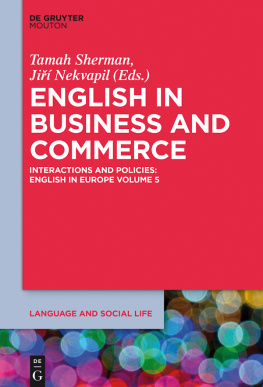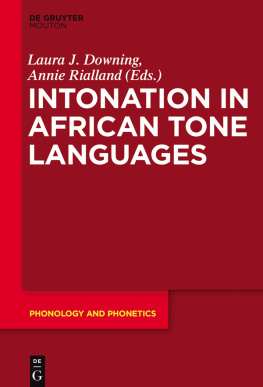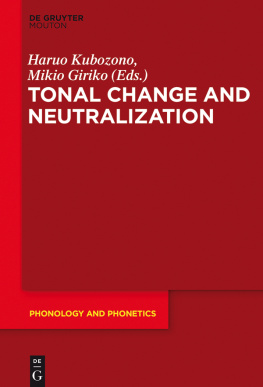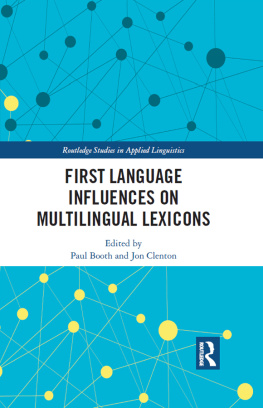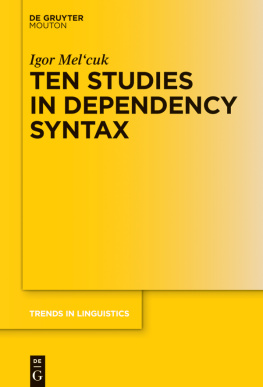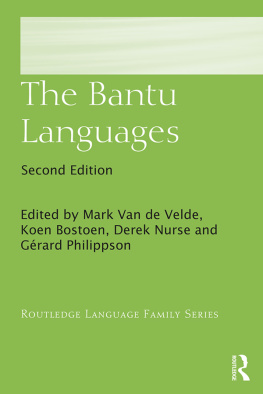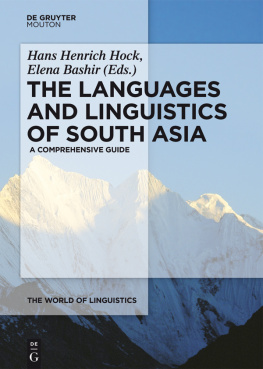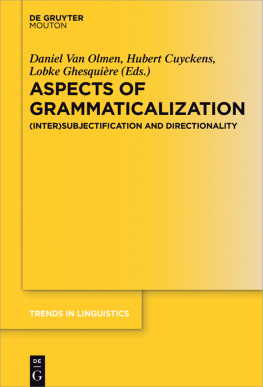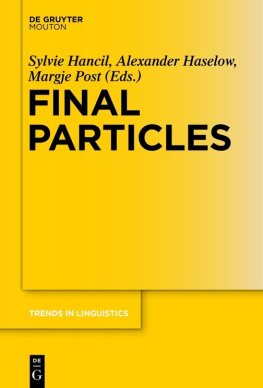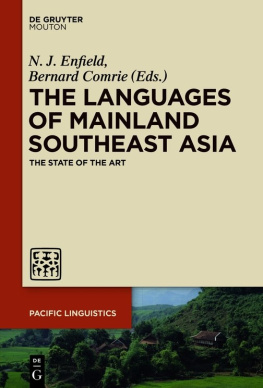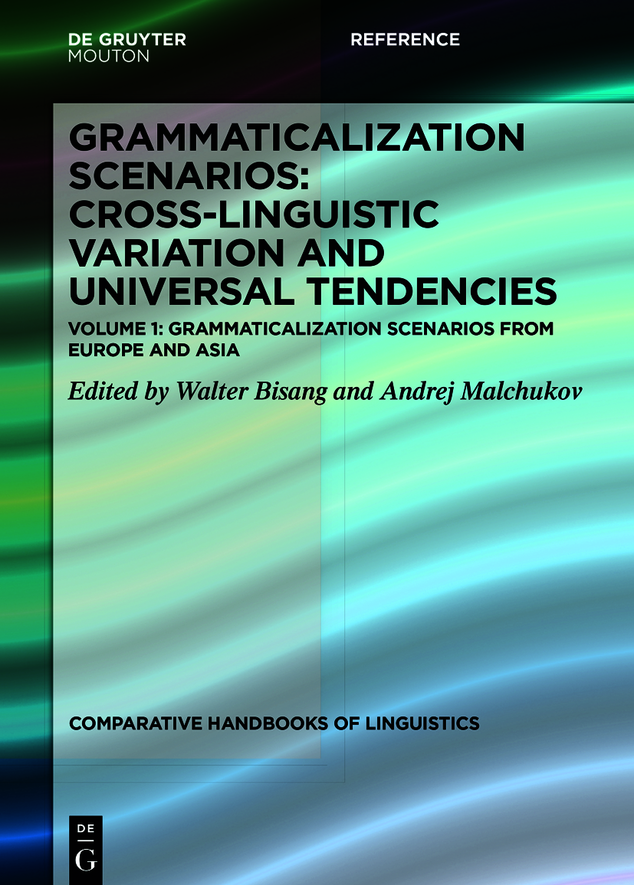Grammaticalization Scenarios
Cross-linguistic Variation and Universal Tendencies
Edited by
Walter Bisang
Andrej Malchukov
Volume 4.1
Comparative Handbooks of Linguistics [CHL]
Edited by
Andrej Malchukov
Edith Moravcsik
Volume 4.1
ISBN 9783110559378
e-ISBN (PDF) 9783110563146
e-ISBN (EPUB) 9783110560442
Bibliographic information published by the Deutsche Nationalbibliothek
The Deutsche Nationalbibliothek lists this publication in the Deutsche Nationalbibliografie; detailed bibliographic data are available on the Internet at http://dnb.dnb.de.
2020 Walter de Gruyter GmbH, Berlin/Boston
Position paper: Universal and areal patterns in grammaticalization
Prof. Dr. Walter Bisang
Johannes Gutenberg-Universitt Mainz, Mainz, Germany
Apl. Prof. Andrej Malchukov
Johannes Gutenberg Universitt, Mainz, Germany
the Mainz Grammaticalization Project team Iris Rieder Linlin Sun Marvin Martiny Svenja Luel
Introduction
1.1 Theoretical preliminaries: accomplishments and open questions in grammaticalization research
Skipping early forerunners like A. W. von Schlegel (1818), studies on grammaticalization started out from Meillet (1912) and Kuryowicz (1965) and were later associated with the work of prominent researchers like Joan Bybee, Talmy Givn, Bernd Heine and Christian Lehmann. Its definition in terms of a lexical item that develops into a grammatical morpheme or from a less grammatical into a more grammatical marker can be seen by now as a classical approach to the phenomenon. In the course of time, research on grammaticalization has become one of the most successful research paradigms introduced in 20th century linguistics. Milestones of grammaticalization research include, among others, such work as Lehmanns (1995) Thoughts on grammaticalization, Heine, Claudi, and Hnnemeyers (1991) Grammaticalization. A conceptual framework, Bybee, Pagliuca, and Perkinss (1994) The evolution of grammar, and Heine and Kutevas (2002) World lexicon of grammaticalization. Even critical voices like Newmeyer (1998, 2001), Campbell and Janda (2001) and others did not discourage research in this field, which currently numbers in the thousands of publications (cf. the monumental Handbook of Grammaticalization by Narrog and Heine [2011] for a state-of-the-art survey of research on grammaticalization). Yet, in spite of its obvious success, some important aspects remain controversial and are in need of further study. Most importantly, it still remains unclear to what extent grammaticalization is subject to cross-linguistic and areal variation. Our project approaches these issues by a systematic quantitative analysis on the basis of data collected from 29 leading experts on different languages and language families across the world. For that purpose, it will focus on source concepts and paths of grammaticalization, on the one hand, and scenarios of grammaticalization as they are defined by the interaction of different parameters and aspects of areality, on the other hand (on the notion of scenario of grammaticalization, also cf. Bisang and Malchukov [2017]). As will become clear in the course of this introductory chapter, we understand our project as a pilot project whose further development will depend on a considerable extension of our data base and most likely also on various aspects of methodology (refinement of the questionnaire and, with increasing availability of data, statistical methods).
The work of Lehmann, Heine and colleagues and Bybee and colleagues is a starting point of prime importance for our research. According to Lehmann, grammaticalization of a linguistic sign is a process in which it loses in autonomy by becoming subject to constraints of the linguistic system (:
Tab. 1 Lehmanns grammaticalization parameters (: 132).
| Axis/Parameter | Paradigmatic | Syntagmatic |
| Weight | Integrity | Structural Scope |
| Cohesion | Paradigmaticity | Bondedness |
| Variability | Paradigmatic Variability | Syntagmatic Variability |
As is clear from : 171173) and in personal communication with our group of how to operationalize various parameters in a way which makes quantification and cross-linguistic comparison possible (cf. questionnaire in chapter2).
The work of Heine and colleagues is of particular relevance for our project because of its findings on grammaticalization paths as they are compiled in the groundbreaking World lexicon of grammaticalization (Heine and Kuteva 2002). This work can be seen as a follow-up and radical extension of Heine and Reh (1984), which documents phenomena of reanalysis and paths of grammaticalization in African languages. We chose a sample of 30 source concepts of grammaticalization from (Heine and Kuteva 2002) for the assessment of typologically widespread and rare paths and their potential areality. Another field of interest that our project shares with Heine and colleagues is areality. While their work is mainly concerned with the way in which grammaticalization operates in situations of language contact (contact-induced grammaticalization; cf. Heine and Kuteva [2005, 2006]), our interest in areality is more focused on how contact and geographic diffusion affect the development of specific, non-universal patterns of grammaticalization, be it in terms of individual paths or in terms of specific interactions between parameters within scenarios of grammaticalization.
The work of Bybee, Pagliuca, and Perkins (1994) is of particular importance for our project because it was the first cross-linguistic quantitative study of grammaticalization. One of its major results was that meaning and form develop in parallel, i.e., that the development of grammatical material is characterized by the dynamic coevolution of meaning and form (Bybee, Pagliuca, and Perkins 1994: 20). We will have more to say about that when we discuss the Parallel Reduction Hypothesis in 3.2. below. As will be clear from the subsequent discussion, our results generally do not support Bybees Parallel Reduction Hypothesis, at least in its strong form, predicting change of form on a particular grammaticalization path, if there is a change in meaning. Still, at a more general level our project owes much to the work of Bybee and her associates, as it represents the second large-scale typological project trying to quantify grammaticalization phenomena.
More recently, research on grammaticalization has experienced new inspirations from Construction Grammar. The advantage of this new perspective is its significant contribution to our understanding of constructionalization, i.e., the emergence of new constructions as new pairings of meaning and form in the context of grammar (Traugott and Trousdale 2013). The role of constructions as the framework within which individual linguistic items change into grammatical markers has long been recognized in the literature on grammaticalization (cf. Bybee, Pagliuca, and Perkins [1994]; Harris and Campbell [1995]; Hopper and Traugott [2003] and many others; also cf. section4.4 on reanalysis and context sensitivity). What is new in research on constructionalization is its focus on the emergence of new constructions within the overall network of constructions that makes the grammar of a language. As was pointed out by Gisborne and Patten (2011), grammaticalization and constructionalization share a number of similarities, among them universality and unidirectionality (constructions universally develop from less schematic to more schematic types of constructions) and gradualness in their historical development. In spite of this, it is an open question to what extent research on grammaticalization and constructionalization actually overlap.


